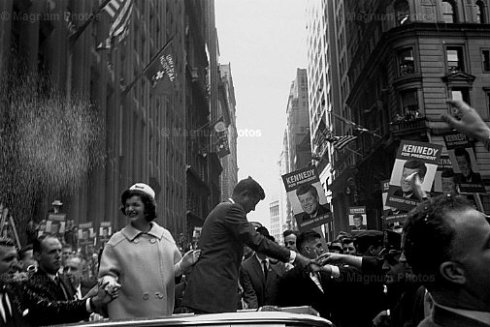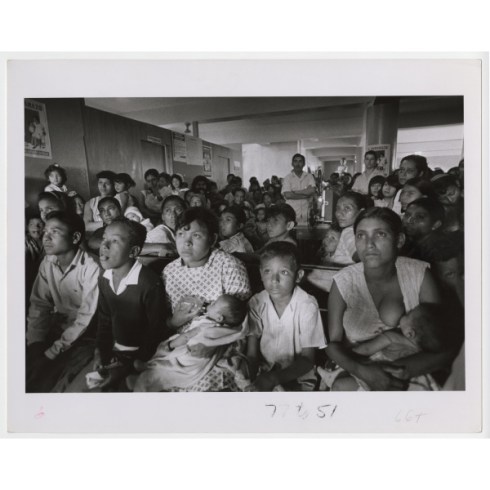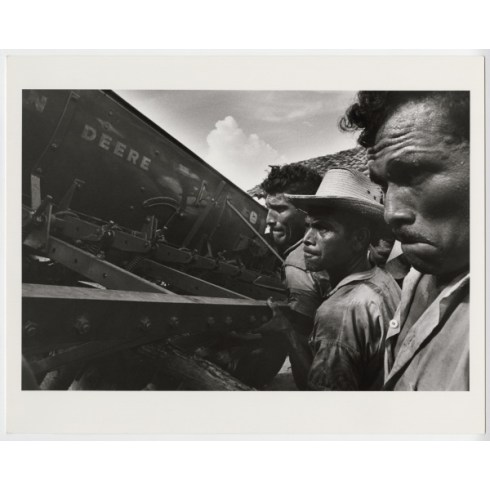
Cornell Capa, to some extent, lived in the shadow of his older brother Robert. I guess, it is easy for complacent men to adore the still and fallen martyr than to keep apace with a passionate and piqued practitioner. Cornell’s and Robert’s legends are one; Cornell ceaselessly fought his brother’s corner authenticity debate surrounding The Falling Soldier.
Cornell’s indebtedness to his brother was fateful and self-imposed:
Disappointingly, it is only in extended surveys of Cornell Capa’s career that mention of his fifties photojournalism in Central and Southern America arises. Otherwise, Cornell is celebrated for his political journalism and particularly his campaign coverage of Adlai E. Stevenson, Jack and Bobby Kennedy. Cornell’s photographs from Latin America are often neglected, even demoted.


The Kennedys were the foci of American progressive attitudes, and so, in the sixties, Cornell documented the concerned politician. Cornell was (not in a negative way) passive and the sixties were not formative. It was in the fifties that he actively worked to define the persona, the ideal: ‘The Concerned Photographer’.


Cornell’s work in Latin America:
In 1956, Cornell was in Nicaragua reporting on the assassination of President Anastasio Somoza García. Somoza was shot by a young Nicaraguan poet; the murder only disrupting slightly the Somoza dynasty that lasted until the revolution of 1979 (that’s where Susan Meiselas picks up).
In the aftermath of the assassination over 1,000 “dissidents” were rounded up. The murder was used as an excuse and means to suppress many, despite the act being that of one man.


I have no knowledge of what happened to these men after Cornell photographed them and I am sure you haven’t the patience for speculative-art-historio-speak.
I do wonder … if having witnessed revolution, early democracies, military juntas, coups, communism, social movements, grand narratives and oppression in various forms, if Cornell picked his subjects with discernment back in the United States.
As early as 1954 Cornell was working on a story for Life about the education of developmentally disabled children and young adults. Up and to that point in time, the subject had been regarded by most American magazines as taboo. The feature was a breakthrough.
In 1966, in memorial to his brother, Robert, and out of his “professed growing anxiety about the diminishing relevance of photojournalism in light of the increasing presence of film footage on television news” Cornell founded the Fund for Concerned Photography. In 1974, this ideal found a bricks and mortar home on 5th Ave & 94th Street in New York: The International Center for Photography.

This institutional limbo that eventually gave rise to one of the world’s most important photography organisations was not a quiet period for Cornell. In 1972, he was commissioned to Attica, NY, to document visually the conditions of the prison. Capa presented his evidence to the McKay report (PDF, Part 1, pages 8-14) the body investigating the cause of the unrest. Cornell narrates his personal observations while showing his photographs to the commission.


At a time when, the photojournalist community seems to have crises of confidence and purpose at an alarming rate, it would be wise to embrace his spirit in full recognition his slow accumulation of remarkable accomplishments.
Rest In Peace, Cornell.

PHOTO CREDITS.
Robert F. Kennedy campaigning in Elmira, New York, September 1964. Accession#: CI.9685
New York City. 1960. Senator John F. KENNEDY and his wife, Jackie, campaigning for the presidency. NYC19480 (CAC1960014 W00020/XX). Copyright Cornell Capa C/Magnum Photos
Three men pushing John Deere machine, Honduras, 1970-73. Accession#: CI.3746
Watching family planning instructional film at Las Crucitas clinic, Tegucigalpa, Honduras], 1970-73. Accession#: CI.8544
Political dissidents arrested after the assassination of Nicaraguan dictator, Anastasio Somoza, Managua, Nicaragua, September 1956. The LIFE Magazine Collection. Accession#: 2009.20.13
NICARAGUA. Managua. 1956. Some of the one thousand political dissidents who were arrested after the assassination of Nicaraguan dictator Anastasio Somoza. NYC19539 (CAC1956012 W00004/09). Copyright Cornell Capa/Magnum Photos
Prisoners escorted from one area to another, Attica Correctional Facility, Attica, New York, March 1972 (printed 2008). Accession#: CI.9693
Two men walking around prison courtyard, Attica Correctional Facility, Attica, New York, March 1972. Accession#: CI.9689
Inmates playing chess from prison cells, Attica Correctional Facility, Attica, New York, March 1972. Accession#: CI.9688
Man on scooter carrying coffin, northeastern Brazil, 1962. Accession#: CI.8921
All photos courtesy of The Robert Capa and Cornell Capa Archive, Promised Gift of Cornell Capa, International Center of Photography. (Except for ‘The Concerned Photographer’ book cover; the Jack Kennedy photograph; & the second Nicaragua prison photograph.)

7 comments
Comments feed for this article
July 3, 2009 at 2:41 am
duckrabbit
Pete, this is an amazing article. It really made me think.
THANK YOU SO MUCH
Benjamin
March 31, 2010 at 8:01 am
POSI+TIVE MAGAZINE > Reportage > Prison Photography
[…] am also proud of my analyses of Jean Gaumy Cornell Capa Jane Evelyn Atwood Jenn Ackerman and Patricia […]
February 12, 2011 at 2:20 am
A Brief History of Prison Photography « Prison Photography
[…] Cornell Capa (Attica, NY, USA); Taro Yamasaki (Michigan), Ken Light (Texas), James Nachtwey (Texas and other Southern states), Bruce Jackson (Arkansas), Alan Pogue (Texas). […]
February 15, 2011 at 4:11 am
Guest Lecture: Pete Brook – ‘Tattoos, scars and tears, Robert Gumpert’s work in San Francisco jails’ « PICBOD – A free and open undergraduate photography class
[…] Cornell Capa (Attica, NY, USA); Taro Yamasaki (Michigan), Ken Light (Texas),James Nachtwey (Texas and other Southern states), Bruce Jackson(Arkansas), Alan Pogue (Texas). […]
September 9, 2011 at 1:01 am
‘Support Prison Rebellions’ Poster, on the 40th Anniversary of the Attica Prison Uprising « Prison Photography
[…] the Attica Prison Uprising before, mainly in relation to Cornell Capa’s involvement in the general politics of prisons and his testimony during the inquiry that followed the […]
May 15, 2012 at 1:11 pm
ENCARCELACION: The Global Post Looks at “Latin America’s Fatal Prison Problem” « Prison Photography
[…] Gary Knight – Joao Pina – Jackie Dewe Matthews – Valerio Bispuri – Pedro Lobo – Vance Jacobs and Columbian prisoners – tourist photography in Bolivian prisons – prison tattoos (some from Central America) – Kate Orlinksky’s portraits of Mexican female prisoners – Fabio Cuttica at a Columbian prison beauty pageant – Patricia Aridjis in Mexico – even Cornell Capa was in Latin American prison at one time. […]
September 15, 2014 at 9:47 am
Critical Resistance’s ‘Attica Interview Project’ Coincides with Calls for Transparency and Truth | Prison Photography
[…] number of inquiries (for example, Cornell Capa’s photographic survey of the facility here and here), however, not all inquiries met or served public need. Suspicions of a cover up of excessive […]